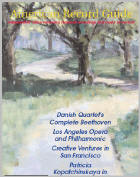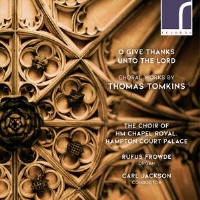Texte paru dans: / Appeared in: |
|
|
Outil de traduction ~ (Très approximatif) |
|
|
Reviewer: Willian
J. Gatens Thomas Tomkins (1572-1656) was born to a family of musicians in St David’s, Wales. His father was organist of the cathedral there. In 1594 the family moved to Gloucester where the elder Tomkins was appointed minor canon and later precentor of the cathedral. The younger Tomkins was probably a pupil of William Byrd, and in 1596 he was appointed organist of Worcester Cathedral. In 1621 he succeeded Edmund Hooper as an organist of the Chapel Royal. As his dates indicate, Tomkins witnessed the suppression of cathedral music during the Common-wealth, but did not live long enough to see its restoration under Charles II. Nevertheless, he remained nominally the cathedral organist at Worcester and resided in the cathedral close for the rest of his life. It is likely that Tomkins’s son Nathaniel supervised the posthumous publication in 1668 of a good deal of his father’s sacred music under the title Musica Deo Sacra. Several of the pieces on the present recording come from that collection. Some of the other pieces are claimed as first recordings. The verse anthem ‘Death Is Swallowed Up in Victory’
was reconstructed by Peter
James from a 17th-Century organ part, a tenor partbook, and a separate
source for the words. The Fourth Service is one of two verse settings of the
evening canticles from Musica Deo Sacra. Unless I have misunderstood
the notes by bass Christian Goursaud, this is the first time both canticles
have been recorded together. Also recorded for the first time is the Seventh
Service, reconstructed by Peter James from a surviving organ part. Verse anthems and services account for most of the music here. Exceptions are the Preces & Responses, brief settings of recurring liturgical texts for Anglican Matins and Evensong; ‘Turn Unto the Lord Our God’, a “sacred madrigal” from Tomkins’s Songs of 3,4, 5, & 6 Parts (1622) that was sometimes sung as a full anthem; and five full anthem settings of psalm texts in four parts for men’s voices. Three organ pieces complete the program: ‘Gloria Tibi Trinitas’ (i.e. In Nomine), A Fantasy, and Voluntary in D. The performance standard is very high. The boys’ intonation and control are especially impressive. The Chapel Royal choir is small compared with cathedral foundations. There are 19 boys listed in the booklet, but it does not sound as if that many are ever singing at one time. There are only 6 men’s voices: two each for alto, tenor, and bass. This produces a rather intimate choral sound that is well suited to the chapel itself. Judging from the photographs in the booklet, it is a lofty room but not an especially large one. Its friendly acoustic is conducive to a good choral blend.
The organ played here by Rufus Frowde is a cabinet instrument by Mander. Its tone is pleasant but rather insubstantial, as so many cabinet organs are. I find the playing too detached and mechanical with little phrase coherence or trajectory, whether in the solo pieces or accompaniments. There are not very many recordings devoted entirely to the music of Tomkins. Of the ones that have come to my attention, the one most like this was recorded by Jeremy Summerly and the Oxford Camerata, (Naxos 553794; M/J 2000). That is a 10-voice ensemble of mixed voices that does not sound to me like a cathedral choir at all. I found their performances technically impressive but not very moving. To a great extent that is also true of these performances. Is it a consequence of the music itself? Tomkins was a highly accomplished and fluent composer, but I find his music less engaging than Orlando Gibbons and Thomas Weelkes, his contemporaries. The only duplication of repertory between this recording and the one from Naxos is the organ voluntary in D. Tomkins was also an important composer of music for viol consort. Some of his anthems survive with consort accompaniment. It is worth noting some remarkable recordings of Tomkins’s consort pieces that include vocal compositions. I was particularly impressed by a sextet of outstanding British early music vocalists with the consort Fretwork
(HM 907320; S/O 2003). Also
worthy of note is the choir of Magdalen College, Oxford under Daniel Hyde
with the consort Phantasm (Opus Arte 9040; J/F 2017). Not long ago I reviewed the debut recording for Resonus of the Gentlemen of the Chapel Royal in a program of music for lower voices by Thomas Tallis (Resonus 10229; S/O 2019). An ensemble of 14 men sang for that, and I was impressed with their tightly knit ensemble, warm and blended tone, and spoton intonation.
Carl Jackson, a native of
London, has been director of music for the Chapel Royal since 1996. Before
that he was organist of Croydon Parish Church (1986-90), sub-organist of the
Chapel Royal (1990-93) and assistant director of music at St Peter’s Church,
Eaton Square (1993-96). We look forward to more recordings from this choir. | |
|
|
|
|
Cliquez l'un ou l'autre
bouton pour découvrir bien d'autres critiques de CD |
|




